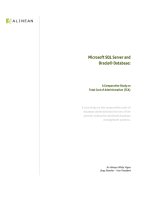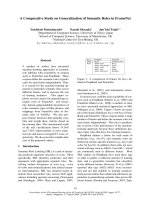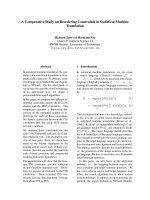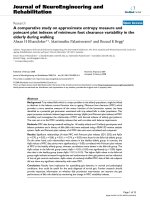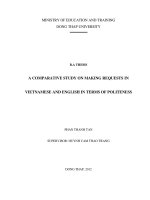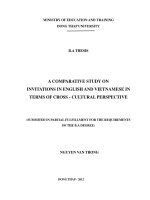b.a thesis a comparative study on making requests in vietnamese and english in terms of politeness
Bạn đang xem bản rút gọn của tài liệu. Xem và tải ngay bản đầy đủ của tài liệu tại đây (1.13 MB, 79 trang )
MINISTRY OF EDUCATION AND TRAINING
DONG THAP UNIVERSITY
B.A THESIS
A COMPARATIVE STUDY ON MAKING REQUESTS IN
VIETNAMESE AND ENGLISH IN TERMS OF POLITENESS
PHAN THANH TAN
SUPERVISOR: HUYNH CAM THAO TRANG
DONG THAP, 2012
i
Acknowledgment
For finishing the thesis, besides my efforts, there are also great contributions of the
supervisor and participants from Vietnam and English-speaking countries as well.
Firstly, I would like to express my sincere gratitude to my supervisor, Ms Huynh
Cam Thao Trang, M.A. for her great guidance, valuable encouragement as well as
comments on the thesis, which makes me possible to complete the thesis before the
due date. In some hard circumstances in which the thesis was not thought to be
finished, I was ever much supported by Ms Thao Trang. Secondly, I am very
grateful for English and Vietnamese participants who do not mind responding to all
questions in the questionnaires. They are not afraid of being bothered while
completing all the questionnaires takes them much time. All of their help is
appreciated and believed to make much contribution to the data collection and
analysis as well.
ii
Abstract
Politeness is now such universal term that everyone can not ignore in
communicaction, particularly in request-making. As a result, politeness strategies
for requests are developed to apply in interaction depending on social contexts in
each culture. This study is done for the sake of finding the differences and
similarities as well in politeness strtegies for requests made by English and
Vietnamese native speakers under the impact of age, gender and social status so that
finally some suggestions for making requests are given to Vietnamese learners of
English to have suitable responses to those from the English culture. Two versions
of questionnaires: one for VNS and the other for ENS are delivered to collect the
data for analysis. Both group have the same number of paticipants (30 for each). The
st as well.
Consequently, the result of the study shows that there are both similarities and
differences in choosing the politeness strategies for requests made by VNS and
ENS. Also, the three factors of gender, age and social status more and less affect
their selection of request strategies.
iii
Table of Contents
Acknowledgment
Abstract
Abbreviations
Chapter 1 INTRODUCTION 1
1. Motivation of the study 1
2. Aims of the study 2
3. Scope of the study 3
4. Significance of the study 3
5. Research method 3
6. Related previous studies 4
7. Organization of the study 4
Chapter 2 LITERATURE REVIEW 6
1. Politeness theory 6
2. Speech act 8
3. Request as a speech act 10
4. Politeness strategies in requests 12
5. Social variables affecting politeness strategies for request-making 17
Chapter 2 METHODOLOGY 20
1. Research questions 20
2. Research participants 20
3. Research procedure 21
4. Method of data collection 21
4.1. Questionnaires 21
4.2. Observation 23
5. Method of data analysis 23
5.1. Statistics 23
5.2. Comparison and contrast 24
iv
Chapter 4 RESULT AND DISCUSSION 24
1. An overview of result 24
2. Requests made by VNS and VNS 26
3. Request making influenced by some factors of social status, gender and age 34
3.1. Social status and age 34
3.2. Social status and gender 42
3.3. Age and gender 48
Chapter 5 CONCLUSION 55
1. Summary 55
2. Pedagogical implications 61
References 63
Appendices 65
v
Abbreviations
CID Conventional indirectness
ENS English native speakers
VNS Vietnamese native speakers
F-T-F Female-to-female
F-T-M Female-to-male
NCID Non-conventional indirectness
1
Chapter 1 INTRODUCTION
1. Motivation of the study
Vietnam is entering the hectic development flow of the world in which international
cooperation in general and cultural, educational exchanges in particular are strongly
pushed up. In fact, learning foreign languages and specially English has been
extremely important. The international language of English has been considered an
effective tool to supportably proceed those activities much more easily. Traditional
language learning, however, is becoming outdated in modern times because only
vocabulary and grammar are focused on. In fact, today English is learnt for
communicative goal, so only vocabulary and grammar is not enough.
Another important element is culture. The communicative goal may definitely fail
to achieve if this element is ignored. It is believed that each country has its own
distinctive features which learners should be paid much attention to. If they do not
eagerly get themselves prepared for knowledge about one culture in which they are
newly involved, lots of misunderstandings and embarrassments will follow when
there are communications and interaction as well. Good preparation for cultural
knowledge will be useful to help the speakers or anyone involved to avoid them.
Maybe a good basis of culture is an advantage over others in social interactions.
Therefore, language and culture have a mutual relationship. In communicative
contexts, their engagement as well as involvement is easily seen. When
communication among people who come from different cultures or even from the
same one occurs, misinterpretations possibly leads to misunderstandings because
each represents his own culture including customs, rituals and etiquettes. In cross-
culture communication, a person usually imposes his individual judgments on
communicative target is impossible to obtain. Obviously cultural understandings
benefit the interlocutors to become successful in communication, perceive certain
ways of speaking more deeply so that they can have suitable reactions. Making
requests which are observed in English and Vietnamese is a good example. It is
2
common and important in daily interaction. Requests show the fact that a language
is not just a simple utterance at all. Many problems will certainly follow if culture
and politeness factors are neglected. The two cultures have their own politeness
standards, so an utterance in general and a request as well in particular may be
acceptable in Vietnamese, but unacceptable in English and vice-versa or the ways
people make requests are different. In some cases, people make direct requests while
others make indirect requests. Obviously, it is very important to get ourselves well
prepared for those matters. No matter how different they are, politeness strategy is
always a desirous goal to reach. On a small scale of cross-culture communication,
the study tries to make clear the contrast between the two speech acts of making
requests in English and Vietnamese. Requests in English and Vietnamese share
some certain similarities, but have differences, too. Vietnamese and English
speakers do not have the same conceptions of what makes a polite request based on
their habits and cultures.
For those reasons, the study of speech act of making requests in English and
Vietnamese is made. It will provide good reference and suggestion to make a good
request and avoid unwanted misinterpretations so that people have more
opportunities to become successful communicators. Therefore, how to make a polite
request to maintain social interactions among interlocutors from different cultures,
keep conversations on and on, get the addressees to carry out what the speakers
expect should be taken into account.
2. Aims of the study
The study aims to
Make comparison and contrast between English and Vietnamese requests and
discuss common strategies for requests made by both ENS and VNS to give an
insight into making requests for Vietnamese learners of English.
Provide some pedagogical suggestions for Vietnamese learners of English.
3
3. Scope of the study
The study is about comparing and contrasting the requests made by ENS and VNS ;
and discuss some common politeness strategies for direct and indirect requests used
by Vietnamese and native English speakers under the impact of social status, age
and gender.
4. Significance of the study
The study involves the speech act of making requests, which sets up social
relationships among people in a particular culture. The speech act is a telling part in
everyday communication. The findings of this study are anticipated making
contribution to learning the ways English and Vietnamese make polite requests so
that Vietnamese learners of English can avoid many problems that follow if they do
not get themselves well prepared for those. The interlocutors in two cultures will
increase more opportunities to understand each other. Hopefully they all become
successful in communication.
5. Research method
In order to achieve the aims study mentioned earlier, the major method to be
employed in the study is delivering questionnaires. Also, contrastive analysis is
used. Therefore, all the considerations, remarks, comments and conclusions in the
thesis are mainly used for data analysis.
For data collection, questionnaires and observations are mainly used. Firstly,
questionnaires are carefully designed to find out what and how the participants in
the study do with the speech act of making polite requests in English and
Vietnamese. Then, the similarities and differences are analyzed and pointed out
what are distinctive features of Vietnamese and English cultures in this area. In
order to collect data for contrastive analysis, two types of questionnaires are
required: one in English and the other in Vietnamese. The English questionnaires are
delivered to thirty native speakers of English in Ho Chi Minh City, where many
foreigners have been living and working and the Vietnamese version are delivered to
4
thirty native speakers of Vietnamese. Secondly, personal observations are also
preceded in different social situations, in which people make requests. Observation
work is done in three different social contexts including university campus,
bookstores and parks. They are important parts in the study in terms of formulating
the hypothesis and making interpretations for the statistics. The observation is useful
to check the theory of making polite in the two cultures in reality.
For data analysis, statistic; comparison and contrast are involved. Firstly, statistics
method in which all the data collected from questionnaires and observation are put
together in one place to analyze and understand it more easily is very important in
data analysis. All responses to the questions in questionnaires are listed and counted
for numbers based on the different politeness strategies for requests made by ENS
and VNS. The number is changed into percentage in each case observed. Secondly,
for the sake of comparison and contrast, the speech act of making requests is
analyzed to find similarities and differences in Vietnamese and English and indicate
some common strategies for requests used by VNS and ENS. That is the big goal of
the study so that all things can be made clear for the speakers and hearers to have
suitable responses and avoid some misunderstandings.
6. Related previous studies
In 2
nd
term 2007, Dau Thi Thanh focused and emphasized on the relationship
between politeness and indirectness used in the speech acts of making requests in
English and Vietnamese. The study pointed some major differences in making
requests in English and Vietnamese. The study mentioned above are helpful to this
study in terms of providing the theoretical background for the thesis as they are
closely related to making polite requests in English and Vietnamese right in the
thesis.
7. Organization of the study
This study is divided into five chapters, as followed
Chapter 1 is introduction, which presents an overview of the study in which the
reason for the research, the aims, the research methods, the scope, the significance
5
of the study, related previous study as well as the organization of the study is briefly
presented.
Chapter 2 is literature review, which includes the theoretical issues relevant to
the study including the theory of speech acts in general and the speech act of request
in particular, politeness in making polite requests in Vietnamese and English,
Chapter 3 is methodology discussing somes issues of research questions,
research participants, research procedure, data collection, and method of analysis.
Chapter 4 presents an overview of results and discusses about the results of
survey questionnaire about request-making in Vietnamese and English; the
politeness strategies for requests made by ENS and VNS under the impact of three
factors: social status, gender and age.
Chapter 5 is conclusion addressing the key issues in the study, summarizing
some shortcomings revealed during the process of completing the thesis, compare,
contrast and synthesize the ways people in the two culture make polite requests so
that Vietnamese learners as well as teachers of English can get some suggestions to
better studying and teaching.
6
Chapter 2: LITERATURE REVIEW
1. Politeness theory
In everyday life, communication is the common activity of human beings. Many
messages are transferred through communication. Verbal acts convey a lot of
different purposes of the speakers. They are used for giving information, expressing
personal viewpoints or making comments, greetings, invitations, compliments,
apology, complaints, or requests. Speakers want hearers to do their intended actions.
depends on the sp
this study, the politeness is referred as an important aspect observed to examine how
it affects the efficiency of communication. Because people in the world always try
their best to be successful communicators, politeness hence can be considered as an
important communicative strategy which helps to maintain good relationships
between speakers and hearers and keep the conversations going on. There have been
many researchers trying to define what is politeness to apply in communication so
that communicative goal can be most successfully achieved. Lakoff (1977) attempts
to account for politeness phenomenon. She suggests that politeness is developed by
society in order to reduce friction in personal interaction and comprises three rules
of politeness:
2. Give options
3. Make the receiver feel good
speaker shows his/her politeness by asking for permission or apologizing in advance
to lessen the imposition on the hearer when requiring the hearer to do something.
in which the linguistic manifestations of politeness appear to leave the choice of
7
accounts for the case in which the speaker employs devices which will make the
addressee feel liked and wanted. The decrease in imposition will be obviously
examined in the examples
(1) Turn the light on ( imposition)
(2)Could you turn the light on? ( less imposition)
(3)I wonder if you could turn the light on. (option)
(4) Darling, turn the light on. (encourage husband or wife to turn the TV
off with much sweet love)
The sentence (1)
where the speaker and the hearer are not in equal position. The speaker seems to
have much more power than the hearer. However, the imposition nature of the last
to increase the politeness makes the hearer comfortable with the least imposition
among that in three left examples. is in for of a question to examine
first one. The force on the hearer seems not serious any more. In example 3, the
hearer feels easy in his/her choice to do the action.
politeness is the concept
-image that every member wants to
According to Brown and
lost, maintained, or enhanced, and must be constantly attended to in interact
aspects of the same entity and refer to two basic desires or wants of any individual.
which are two related in any interaction. In fact, positive face is defined as the
necessity to be accepted by at least some others, whereas negative face is described
8
as the desire to be independent, the desire that the action is unimpeded by others.
Following their theories, in communication, there is possibility of appearing some
Face Threatening Acts (FTA) which
w
deal with those acts, they identify a set of strategies which can help either to avoid
or minimize them. In their opinion, positive face threatening acts should be adjusted
by
threatening acts should be solved by applying negative politeness strategies, some of
which are: conventional and non-conventional indirectness; questions, hedge that
help to minimize the imposition.
In general, those scholars agree that politeness strategies applied in utterances are
paid much attention so that the speakers avoid the imposition on the hearers and
then make them possible to achieve their goal.
2. Speech act theory
In reality, lots of different physical acts based on the body movements such as
cooking, eating, driving, gardening and so on are performed. Besides those physical
acts, verbal acts are also important and effective in communication. All of them
is undoubted that people can accomplish a lot of things through verbal acts. Some
examples of telephone calls, letters, and reports have the value of information
transfer. They may be in forms of word or sound. No matter what they are, verbal
acts still work well and have certain power of information transfer themselves. It can
be inferred that language is the principal tool to carry out hundreds of tasks in a
typical day. In order to learn the nature of an utterance, linguists have been done
many researches in this area. As a result, pragmatics in which utterances are
examined from different corners appeared.
9
Pragmatics has been defined as the study of how utterances have meanings
in speech situations with speakers and hearers involved. Utterance meaning is the
main research object in pragmatics, whereas semantics focuses on sentence
meaning. For instance, from a pragmatic point of view, a statement like
can be an assertion about the weather, a request to turn on the air
conditioner, or some other speech act, depending on the intention of the speaker in
specific situations. By contrast, from a semantic point of view, it has only a single
meaning. By that way, it only indicates the state of the weather: hot and not
comfortable. Evidently, depending
meaning would be aimed at. Possibly, the sentence above is a good example about
the speech act if the only first one is most referred. As can be seen, a sentence is not
just a simple utterance also does a specific action. As a matter of fact, the term of
speech act is discussed. The theory of speech acts has been studied for ages, but it
was Austin who was considered the first person to set foundation for the theory of
speech acts. He postulates that many utterances do not communicate information,
but are equivalent to actions. These utterances are called speech acts.
Yule (
themselves, people do not only produce utterances containing grammatical
actions performed via utterances are speech acts. They may be given some specific
labels such as apology, complaint, compliment, invitation, promise or request.
Because people often do more things with words than merely convey what words
encode, speech acts have to be seen from real-life interactions. For example, in a
classroom situation, when a teacher says:
(5) May I have your attention?
The sentence is a request more than a question. The distance between what is said
and what is meant, and the multiple layers of meaning between the literal meaning
of utterance and the act which it performs in context are very different. Some
10
utterances are not statements or question about some piece of information, but are
actions. In this case, it is really a request which asks the hearer to pay attention, stop
making noise.
of acts: the locutionary acts of which the meaning can be totally taken from that of
individual linguistic elements forming the utterance; the illocutionary acts through
which the speakers express their intention to do something in such a way that the
listener can recognize them as well and the perlocutionary acts through which the
utterance can produce certain consequential effects upon the feelings, thoughts or
actions of the audience.
3. Request as a speech act
As discussed above, what is said is not just a simple utterance. In fact, there are lots
of layers of meanings which send different messages under that utterance.
Therefore, realizing which intention is wanted by the speakers is rather difficult.
Similarly, requests are complex speech acts which involve a relationship of different
elements. These elements have been identified by Blum-Kulka (1991) as the request
schema which includes requestive goals subject to a cultural filter, linguistic
encoding (strategies, perspective and modifiers), situational parameters (distance,
power and legitimization) and the social meaning of the request according to cultural
and situational factors.
In fact, requesting is defined as an act of requiring the other(s) to do something
performed through utterance(s) in interaction. As the speaker makes a request, s/he
three general kinds of
speech acts classified by Austin: the locutionary (the linguistic utterance of the
speaker), the illocutionary (what the speaker intends) and the perlocutionary (the
eventual effect on the hearer), the speech act of request considered one of the most
11
sensitive illocutionary acts in communication. Then Searle puts forward a taxonomy
of illocutionary acts which is further elaborated by Yule (1996), including
directives, commissives, expressives, representatives and declarations. Among them,
directives are those speech acts whose function is to get the hearer to do something.
As attempts on the part of a speaker to get the hearer to perform or stop performing
some kind of action, requests are therefore labeled as one type of directives.
Obviously, a request is an illocutionary act where a speaker (requester) conveys to a
hearer (requestee) that he/she wants the requestee to perform an act which benefits
the speaker (sometimes for someone else). Requests are intrinsical face-threatening
acts for the following reason: by making a request, the speaker may threaten the
freedom of action,
(Brown & Levinson, 1987:65) and also runs the risk of losing face him/herself. In
fact, in English, request can be linguistically realized with imperatives,
interrogatives and declaratives. However, Lyons (1968) states that the conversation
requirements of politeness usually render it awkward to issue flat imperatives for
making request. Leech (1983) explains that imperatives are the least polite
constructions since they are tactless in that they jeopardize compliance by the
addressee. For this reason indirect means are usually sought to realize illocutionary
needs. In other word, ENS prefer to employ indirect ways of requesting someone for
something because the more directness there is in making request, the more
imposition the requestees suffer. As a result, the face of requestees is increasingly
damaged. VNS however use imperatives or direct requests with overwhelming
majority. That is the problem here. Preference for direct requests made by VNS
-strategy
selection is determined by their cultural norms.
considerations, Brown and Levinson (1987) have developed an explicit model of
politeness that they claim to have validity across cultures. The basic idea is to
understand various strategies for interaction between the individuals of a certain
community. The matter would be found out in the next part.
12
4. Politeness strategies in requests
According to Sifianou (1992), most scholars, basing on the investigation of English,
have argued that the degree of indirectness determines the degree of politeness to a
great extent. The main reason for this argument reasonably originates from the
concept of Western individualism. It is widely accepted that most English speaking
societies place a higher value on privacy and individualism (i.e., the negative aspect
of fa
words, to Western societies in general and to most English speaking societies in
particular, the principle of distance and non-imposition plays a crucial role in social
interactions. Although there are some ideas that indirectness and politeness are not
the same (Kasper, 1998; Holtgraves, 1986), most scholars have argued that overall,
in English, indirectness and politeness are closely related, especially in request- a
kind of directive speech acts. While the scale of indirectness seems to be universal,
the assertion between indirectness and politeness differ across cultures. Contrary to
most English societies where the display of non-imposition and concerns for
distancing in speech acts are believed to help avoid face threatening acts and hence
to be more polite, a number of cultures such as Vietnam prefer a show of solidarity
and sincerity by directly deliver them. Sifianou (1992) has proved that Greeks
request, advise and suggest structurally more directly than English because they see
those acts as their duty to help and support each other without any idea about
imposition or non-imposition. In another study which examines the politeness
perceptions of speakers of Israeli Hebrew, Blum-Kulka (1987) finds that speakers of
Hebrew favor directness rather than indirectness. Generally speaking, speakers from
those mentioned cultures either seem to pay much attention to involvement and
solidarity relation, i.e. the positive aspect of face, or belong to a kind of societies
such as Vietnam where people depend on each other more and therefore individuals
are less emphasized than interdependent social relations like English speaking
societies. In other words, most of them probably correspond to positive politeness
societies where indirectness will not necessarily be related to politeness.
13
Indirect speech acts in relation to politeness phenomenon in Vietnamese have just
recei) on English and Vietnamese
indirect requests. Her arguments are rather reasonable. She says that indirectness
with the concept of non-imposition is not necessarily politeness in Vietnamese
culture. Because politeness in requesting in Vietnamese does not only completely
depend on the levels of directness-indirectness or imposition-optionality but also on
other factors such as how illocutionary meaning is understood, and socio-cultural
factors.
Although Vietnamese and English have different conceptions of politeness in
relation to indirectness, both are highly aware of the advantages of politeness and
appreciate it in making speech acts in general and request in particular. Politeness is
useful to help speakers convey utterance, intentions in an effective way; increase the
possibility of the action implementation then and avoid the force on the hearers. As
a result, both hearers and speakers are comfortable. To have a good base for a better
analysis of the politeness strategies for request-making used by Vietnamese and
English native speakers and for, this study bases on the classification of requests in
some cross-cultural interlingual studies of speech acts by Brown & Levinson(1987),
they classify requests into nine sub-ones.
14
4. Obligation statement: utterances which
state the obligation of the hearer to carry
out the act.
9. Mild hints: utterances that makes no
reference to the request proper (or any of its
element) but are interpretable as requests by
context.
5. Want statement: utterances which state
out the act.
6. Suggestory formulae: utterances which
contains a suggestion to do X
7. Query preparatory: utterances
containing reference to preparatory
conditions (e.g., ability, willingness) as
conventionalized in any specific language.
8. Strong hints: utterances containing
partial references to object or element
needed for the implementation of the act.
2. Perfomatives: utterances in which the
illocutionary force is explicitly named.
1. Mood derivable: utterances in which the
grammatical mood of the verb signals
illocutionary force.
3. Hedged performatives: utterances in
which the naming of the illocutionary force
is modified by hedging expressions force.
Direct
Conventionally
indirect
Non-
conventionally
indirect
As discussed above, directness and indirectness exist in speech acts in general and
the speech act of request in particular. Requests can be divided into direct and
indirect ones. Both direct and indirect requests are described as types above. The
first five ones belong to direct strategy and the last four ones belong to indirect
strategy. Also, indirect requests are divided into two kinds: conventional and
15
unconventional ones. The following sentences are good examples for politeness
strategies for request according to Brown and Levinsonion.
Categories of requests
English requests
Vietnamese requests
1. Mood derivable
Please keep it secret!
(Xin)
.
2. Performative
I request you to keep it
secret.
Bác con phi
.
3. Hedged performative
I have to ask you to keep
it secret
.
4. Obligatory statement
You have to keep it
secret.
.
5. Want statement
I would like you to keep
it secret.
.
6. Suggestory formulae
secret?
?
7. Query preparatory
Mr Brown, would you
mind keeping it secret?
c
.
8. Strong hint
I am sad if you tell
anyone this secret
9. Mild hint
My wife know the truth, I
will be kicked out.
.
16
From responses for each context above, there are some common things that VNS
and ENS share in terms politeness in requests. The high-p
noticeable thing in both English and Vietnamese imperatives and sometimes in
p
reduce force on the hearers. Its positive effect helps create comfortably
communicative environment. This is really meaningful to Vietnamese direct
requests because please
, which makes ENS believe that
directness possibly creates the so-
However, one basic different thing that increases the politeness of the Vietnamese
direct requests is address-term use. Depending age, gender, position of the
requesstees, VNS use different address-terms -. In the example
ác-=uncle-ôi-anh=I -
-cô=I- to show their respect. As can be seen, the relationship
between the speaker and the hearer can be changed if there is change in the address-
term use. Therefore, daily communication, the address-terms should be taken into
consideration.
In addition, ENS tend to use family name followed by Mr in (7) as a way of
respect-showing in formal contexts. Nevertheless, sometimes VNS and ENS use
titles before making requests, which is believed to be close to politeness. The the
example (7) obviously indicates relationship between the higher position and the
lower one. The in (7) upgrades the level of politeness
of the employer to the boss.
As listed above, some easily seen elements to increase politeness in ENS and VNS
requests are more and less believed to be useful information. However, there are
other factors that determine their politeness strategies for requests. Both Vietnamese
and English requests will be analyzed based the classification by Brown and
Levinson to investigate which strategies are most favored by each group. As can be
17
by means what he says. It is also regarded as a face-threatening act, which involves
nding a good strategy
without face damage for keeping the conversation going on is necessary for each
one in society.
5. Social variables affecting politeness strategies for request-making
Each person from each society (Vietnam or English-speaking countries) has
different selection of politeness strategies for request-making. Obviously, cultural
difference is the main reason for that. However in a smaller aspect, social
perspective, it is believed that some social factors such as social status, gender and
age more and less affect the way of speaking in general and requesting in particular.
Such factors are carefully examined and discussed to discover how differently
strategies for requests are used by people from each culture.
First at all, power or social status and politeness are closely related. According to
Brown and Levinson (1987: 77), power or social status is an asymmetric social
dimension of relative power involving the degree to which hearer can impose his/her
self-evaluation (face) at the expens -evaluation.
Brown and Levinson say that the greater the power hierarchy distance, the more
redressive strategies will be used by the less powerful interactant. As a result, in
situation where there is explicit hierarchical difference between participants like the
relationship between a boss and an employee, a professor and a student or between
people of higher and lower social status in general, the politeness strategies used is
relatively predictable. The more powerful the requester is in relation to the
requestee, the more polite the requester would be. Then, in situation where that
difference is not clear like the relationship between close friends or between people
of equal social status, participants are expected to adopt various politeness strategies
in particular circumstances .
Secondly, gender is undoubtedly is also an element influencing the request-making
between males and females. Nowadays it is widely accepted that women and men
tends to be cooperative in character in that women
18
women value is connection, intimacy and solidarity, so they are likely to insist on
the commonality of their experience, not its uniqueness in talking. They seek
conversations are less social and more individualistic and aim at controlling the flow
any individual may be one-up or
one-
status. As a result, their speech shows a tendency to seek independencies and focus
on hierarchical relationship as Chodorou (1978) ever stated.
Concerning the differences of gender politeness in making requests, Holmes (1996)
says that because they are more sensitive to the positive face needs of intimates and
friends, women are much more likely than men to express positive politeness or
fr
However, in public, being well aware of the fact that what they say may threaten
face of other people, women tend to use the extremes of negative politeness more
frequently than men do. Similarly, McKay (1996: 251) suggest that men are more
likely to be polite in a way that honors the wishes of others not to be imposed upon
(negative politeness) rather than polite in a way that recognizes the desire of others
to be liked, admired and ratified (positive politeness).
In Vietnamese culture, it is believed that straightforwardness is one of the most
typical qualities for men while women usually prefer
which is a sign of the stylistic variation in language use between females and males.
Besides, like in most English speaking societies, under the influence of social,
cultural and historical factors which govern the reciprocal social status between
women and men as well as different social expectations on them and so on, there are
obviously many empirical evidences for gender differences in other aspects of
Vietnamese language use such as lexical variation, intonation contours, voice
quality, etc. Gender differences in language use seem to be universal. The
19
difference, if there is any between males and females in English and Vietnamese
cultures, will partly reflect their opinions on politeness in issuing requests. In other
words, the question of how gender as a social variable affects the choice of making
indirect or direct spoken invitations in English and Vietnamese is still under the
need of investigation for the purpose of the study and will be discussed later
Finally, it is really not enough if the factor of age is ignored in investigating
politeness strategies for requests under the influence of social factors. Apart from
gender and social status, age is also a social variable which influences significantly
and differently to human behavior in different cultures. Vietnam, an Asian culture in
general emphasizes the importance of age related to respect and the amount of
wisdom a person has. When a person gets older, (s)he is believed to become wiser.
So, elderly people are often given the right to decide important things within the
family. Besides, the older a person is, the more respect (s)he would receive from the
young people. As a result, when requesting the older, speech act done buy
Vietnamese is considered to be high deference. As a matter of fact, age obviously
has a significant impact on speech behavior in social communication. Vietnamese
people always try to know the age of interlocutors to choose the appropriate terms of
address for polite purpose. That explains the reason why Vietnamese often have the
habit of asking the age of any people they communicate, which normally irritates
many Westerners. Conversational style and politeness strategy of Vietnamese
people to people of various age levels is quite different. Meanwhile, it seems that
English native speakers do not take age factor into great consideration. Though they
do respect elderly people, the age of addressees is not considered to be the factor
that automatically decides the amount of respect. Westerners tend to demand more
information and interaction before showing their respect to someone. To them, age
is just as important as other social factors. A person would be respected for his own
values not because of his age. Therefore, less deference and control is given to
elderly people in the majority of those cultures in comparison to most Asian cultures
and Vietnamese one specifically. The differences between Western and Asian ideas
